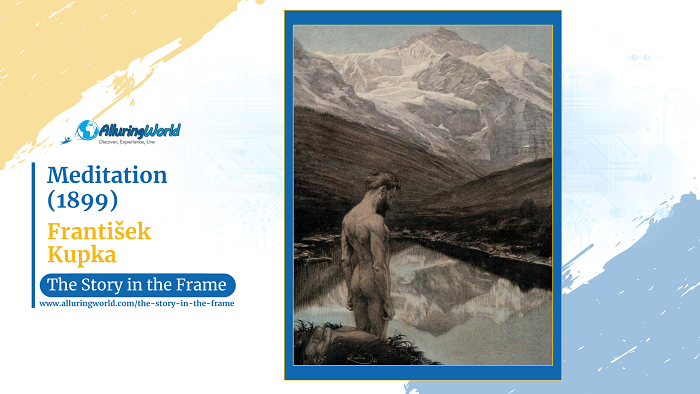František Kupka, considered to be a pioneer of abstract art, is often celebrated for his vibrant and dynamic compositions that pushed the boundaries of visual expression, however, his artistic journey began with a deep exploration of symbolism and spiritual themes, as evident in his early work, Meditation. This captivating painting invites viewers to contemplate the profound connection between humanity and the natural world, revealing Kupka’s introspective and philosophical approach to art.
About the Painter:
František Kupka (1871-1957) was a Czech painter and graphic artist who played a pivotal role in the development of abstract art. Initially drawn to symbolism and spiritualism, Kupka’s early works often depicted mystical and allegorical subjects, but as his career progressed, he gradually transitioned towards abstraction, exploring the expressive potential of color and form. Kupka’s unique style, characterized by its vibrant hues and dynamic compositions, solidified his position as a leading figure in the modern art movement.
Inspiration and Reasons Behind the Painting:
Meditation, which was created around 1899, reflects Kupka’s fascination with the intersection of human existence and the vastness of nature. The painting can be interpreted as a visual representation of the artist’s own spiritual quest, seeking harmony and understanding within the natural world, nonetheless, Kupka’s interest in philosophy, particularly the works of Friedrich Nietzsche, may have also influenced the painting’s themes of self-discovery and the interconnectedness of all things.
What is Depicted in the Painting:
The painting features a solitary male nude, kneeling with his back to the viewer, gazing upon a serene mountain lake and the reflection of the towering peaks in the water creates a sense of depth and tranquility. The man’s posture suggests contemplation and introspection, inviting viewers to join him in his communion with nature, and the surrounding landscape, with its majestic mountains and tranquil lake, evokes a sense of awe and wonder, emphasizing the power and beauty of the natural world.
Colors and Techniques:
Kupka employs a muted color palette, primarily using earthy tones and soft blues to create a serene and contemplative atmosphere. The painting’s smooth, blended brushstrokes contribute to its dreamlike quality, further enhancing the sense of introspection and spiritual reflection, and the subtle play of light and shadow on the man’s body adds a touch of realism, grounding the scene in the physical world while still maintaining its ethereal quality.
Conclusion:
Overall, Meditation stands as a testament to Kupka’s early artistic explorations, revealing his deep interest in symbolism, spirituality, and the profound connection between humanity and nature. The painting’s serene imagery and contemplative atmosphere invite viewers to reflect on their own place in the world and the search for meaning and understanding, and while Kupka later moved towards abstraction, Meditation provides a glimpse into the artist’s formative years, showcasing his ability to capture the essence of human experience within the vast and awe-inspiring landscape.

